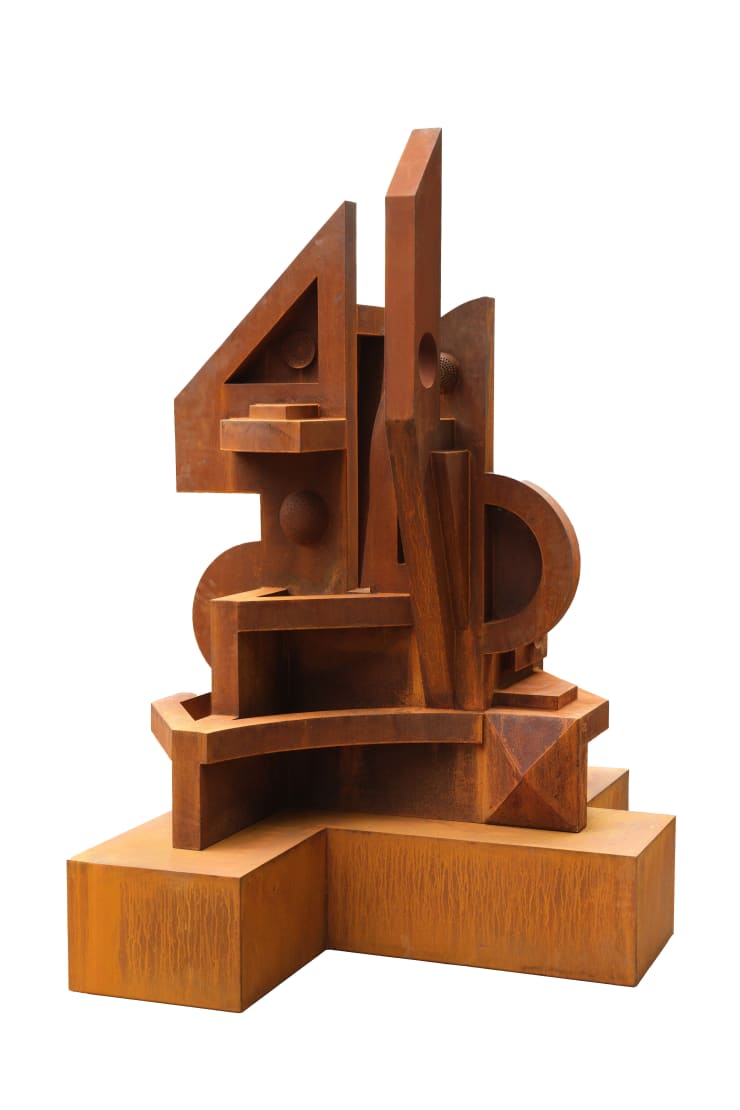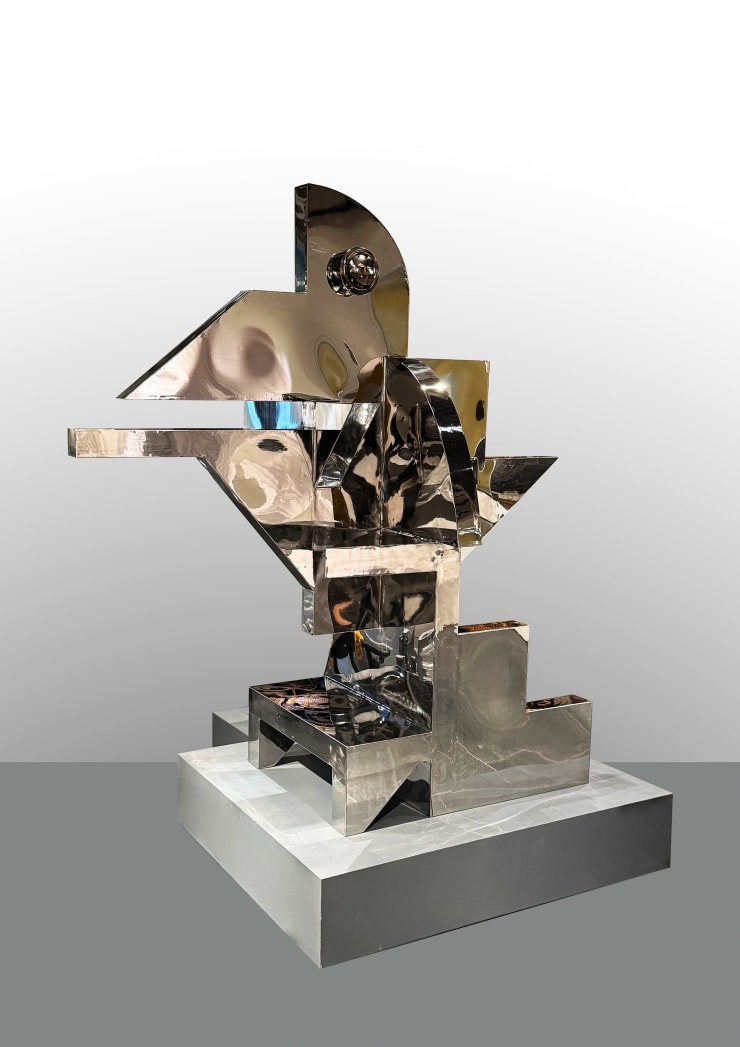Every age has searched for a cipher to unlock the sacred and divine. From the mandalas of Asia to the cathedrals of Europe, from alchemical diagrams to the blueprints of modern industry, artists and builders have turned to geometry as a code that binds material and spiritual worlds. In the recent works of Rakesh Patel, this quest re-emerges with striking force. His reliefs, diagrams, and sculptures are not mere abstractions but sacred ciphers that are coded structures where shapes and colours conceal both memory and transcendence. Patel’s practice spans the intimate and the monumental, moving across paper, wood, and steel. On paper, he distills yantra-like geometries into stark diagrams: black and gray compositions punctuated with flashes of red, yellow, or blue. These are intimate code, blueprints that hover between sacred diagrams and modernist design. In his wooden reliefs and painted sculptures, geometry acquires depth, rhythm, and tactility. Carpentry fragments, rods, and spindles interlock into mandala-like structures; surfaces are distressed and weathered, carrying the aura of ancient relics. And in steel, Patel’s language rises to the monumental: rusting planes and intersecting arcs that command outdoor space, at once a shrine, a ruin, and a machine.
This arc of Diagram → Relief → Monument is central to Patel’s vision. Each medium does not stand apart, but unfolds into the next: the diagram becomes relief, the relief becomes a monument. A yantra drawn on paper becomes a wall-based shrine; a shrine expands into a steel structure for civic contemplation. Across this continuum, Patel insists that geometry is not a relic of the past but a living cipher, equally at home in the courtyard, the gallery, and the public square.
Patel engages multiple lineages, but his work refuses the closure of either tradition or modernism, dwelling instead in the fertile space between. His reliefs recall the facades of Gujarati and Rajasthani temples, with their compartmentalised niches and rhythmic ornament. Yet they also echo the assemblages of Louise Nevelson, who transformed wooden fragments into monumental abstractions. Where Nevelson cloaked her works in monochrome, Patel infuses his fragments with colour-coded symbolism, anchoring centers of energy like ritual bindus. His steel works resonate with Constructivist monuments, with Anthony Caro and Eduardo Chillida, yet their rusting patina also makes them read as sacred ruins, industrial relics that have absorbed the passage of time. Within South Asian modernism, Patel’s closest kin may be S.H. Raza, who invested modern abstraction with the spiritual resonance of the Bindu, and Nek Chand, whose Rock Garden reclaimed fragments into a visionary landscape.
The exhibition Scared Cipher unfolds as a flow of thematic resonances. Geometry appears as cosmos: circles and triangles as diagrams of infinity, maps of order. Assemblage follows as memory: carpentry remnants and weathered textures as cultural relics recomposed into shrines. The sacred and industrial intertwine: rods and gears echo machinery but also resemble ritual devices. Finally, architecture emerges as a shrine: reliefs read like facades, monuments like temples without deities, altars where from itself is divine.
As Patel’s series God in my Courtyard suggests, sanctity resides in the spaces we inhabit daily. His works are not nostalgic reconstructions or secular abstractions but hybrid sanctums, machines of devotion coded with sacred geometry. They invite us to read the world itself as a sacred diagram: rust as prayer, fragments as relics, machines as altars.
The cipher is never given outright: it must be deciphered. But Patel shows us that the divine has not disappeared; it has only changed form, inscribed in the very structures of the world we inhabit.
This arc of Diagram → Relief → Monument is central to Patel’s vision. Each medium does not stand apart, but unfolds into the next: the diagram becomes relief, the relief becomes a monument. A yantra drawn on paper becomes a wall-based shrine; a shrine expands into a steel structure for civic contemplation. Across this continuum, Patel insists that geometry is not a relic of the past but a living cipher, equally at home in the courtyard, the gallery, and the public square.
Patel engages multiple lineages, but his work refuses the closure of either tradition or modernism, dwelling instead in the fertile space between. His reliefs recall the facades of Gujarati and Rajasthani temples, with their compartmentalised niches and rhythmic ornament. Yet they also echo the assemblages of Louise Nevelson, who transformed wooden fragments into monumental abstractions. Where Nevelson cloaked her works in monochrome, Patel infuses his fragments with colour-coded symbolism, anchoring centers of energy like ritual bindus. His steel works resonate with Constructivist monuments, with Anthony Caro and Eduardo Chillida, yet their rusting patina also makes them read as sacred ruins, industrial relics that have absorbed the passage of time. Within South Asian modernism, Patel’s closest kin may be S.H. Raza, who invested modern abstraction with the spiritual resonance of the Bindu, and Nek Chand, whose Rock Garden reclaimed fragments into a visionary landscape.
The exhibition Scared Cipher unfolds as a flow of thematic resonances. Geometry appears as cosmos: circles and triangles as diagrams of infinity, maps of order. Assemblage follows as memory: carpentry remnants and weathered textures as cultural relics recomposed into shrines. The sacred and industrial intertwine: rods and gears echo machinery but also resemble ritual devices. Finally, architecture emerges as a shrine: reliefs read like facades, monuments like temples without deities, altars where from itself is divine.
As Patel’s series God in my Courtyard suggests, sanctity resides in the spaces we inhabit daily. His works are not nostalgic reconstructions or secular abstractions but hybrid sanctums, machines of devotion coded with sacred geometry. They invite us to read the world itself as a sacred diagram: rust as prayer, fragments as relics, machines as altars.
The cipher is never given outright: it must be deciphered. But Patel shows us that the divine has not disappeared; it has only changed form, inscribed in the very structures of the world we inhabit.
Satyajit Dave
Mumbai September 2025
-
 Rakesh PatelGod is in my courtyard "Sacred Cipher" , 2025Corten Steel
Rakesh PatelGod is in my courtyard "Sacred Cipher" , 2025Corten Steel
Acquired by Nisa Family Trust ( Mrs Gayatri Ankit Chona)78" (h) x 60" (w) x 48" (l)Sold -
 Rakesh PatelGod is in my courtyard "Sacred Cipher" , 2025Corten Steel90" (h) x 58" (w) x 51" (l)
Rakesh PatelGod is in my courtyard "Sacred Cipher" , 2025Corten Steel90" (h) x 58" (w) x 51" (l) -
 Rakesh PatelGod is in my courtyard "Sacred Cipher" , 2025Corten steel78" (h) x 68" (w) x 60" (l)
Rakesh PatelGod is in my courtyard "Sacred Cipher" , 2025Corten steel78" (h) x 68" (w) x 60" (l) -
 Rakesh PatelGod is in My Courtyard "Sacred Cipher" , 2025Mix Media Wood48" X 48" X 4"
Rakesh PatelGod is in My Courtyard "Sacred Cipher" , 2025Mix Media Wood48" X 48" X 4" -
 Rakesh PatelGod is in My Courtyard "Sacred Cipher" , 2025Mix Media Wood48" X 48" X 4"Sold
Rakesh PatelGod is in My Courtyard "Sacred Cipher" , 2025Mix Media Wood48" X 48" X 4"Sold -
 Rakesh PatelGod is in My Courtyard "Sacred Cipher" , 2025Mix Media Wood48" X 48" X 4"
Rakesh PatelGod is in My Courtyard "Sacred Cipher" , 2025Mix Media Wood48" X 48" X 4" -
 Rakesh PatelGod is in My Courtyard "Sacred Cipher" , 2025Mix Media Wood48" X 48" X 4"
Rakesh PatelGod is in My Courtyard "Sacred Cipher" , 2025Mix Media Wood48" X 48" X 4" -
 Rakesh Patel"Sacred Cipher" , 2025Stainless Steel78" (h) x 66" (w) x 56" (l)
Rakesh Patel"Sacred Cipher" , 2025Stainless Steel78" (h) x 66" (w) x 56" (l) -
 Rakesh PatelGod is in My Courtyard "Sacred Cipher" , 2025Mix Media Wood48" X 48" X 4"
Rakesh PatelGod is in My Courtyard "Sacred Cipher" , 2025Mix Media Wood48" X 48" X 4" -
 Rakesh PatelGod is in My Courtyard "Sacred Cipher" , 2025Mix Media Wood48" X 48" X 4"Sold
Rakesh PatelGod is in My Courtyard "Sacred Cipher" , 2025Mix Media Wood48" X 48" X 4"Sold -
 Rakesh PatelGod is in my courtyard "Sacred Cipher" , 2025Stainless Steel80" (h) x 60" (w) x 57" (l)
Rakesh PatelGod is in my courtyard "Sacred Cipher" , 2025Stainless Steel80" (h) x 60" (w) x 57" (l) -
 Rakesh PatelGod is in My Courtyard "Sacred Cipher" , 2025Mix Media Wood48" X 48" X 4"
Rakesh PatelGod is in My Courtyard "Sacred Cipher" , 2025Mix Media Wood48" X 48" X 4"
25% to charity
75% to artist/ gallery -
 Rakesh PatelGod is in My Courtyard "Sacred Cipher" , 2025Mixed Media on Wood81" X 118" X 4"
Rakesh PatelGod is in My Courtyard "Sacred Cipher" , 2025Mixed Media on Wood81" X 118" X 4"
25% to charity
75% to gallery/artist -
 Rakesh PatelGod is in my courtyard "Sacred Cipher" , 2025Acrylic on boilo sheet88" (h) x 42" (w) x 38" (l)
Rakesh PatelGod is in my courtyard "Sacred Cipher" , 2025Acrylic on boilo sheet88" (h) x 42" (w) x 38" (l) -
 Rakesh PatelGod is in My Courtyard "Sacred Cipher" , 2025Mixed Media on Wood
Rakesh PatelGod is in My Courtyard "Sacred Cipher" , 2025Mixed Media on Wood
Acquired by Pooja and Lalit Choudhary (Infinity BMW, Mumbai)48" X 102" X 4"Sold
-
 Rakesh Patel"Sacred Cipher" , 2025Acrylic on WPC Sheet48" X 48" X 4"
Rakesh Patel"Sacred Cipher" , 2025Acrylic on WPC Sheet48" X 48" X 4"
25% to charity
75% to artist/ gallery -
 Rakesh Patel"Sacred Cipher" , 2025Acrylic on WPC Sheet24" X 24" X 4"
Rakesh Patel"Sacred Cipher" , 2025Acrylic on WPC Sheet24" X 24" X 4" -
 Rakesh Patel"Sacred Cipher" , 2025Acrylic on WPC Sheet48" X 48" X 4"
Rakesh Patel"Sacred Cipher" , 2025Acrylic on WPC Sheet48" X 48" X 4"
25% to charity
75% to artist/ gallery -
 Rakesh Patel"Sacred Cipher" , 2025Acrylic on WPC Sheet48" X 48" X 4"
Rakesh Patel"Sacred Cipher" , 2025Acrylic on WPC Sheet48" X 48" X 4" -
 Rakesh Patel"Sacred Cipher" , 2025Acrylic on WPC Sheet24"X 24" X 4"
Rakesh Patel"Sacred Cipher" , 2025Acrylic on WPC Sheet24"X 24" X 4" -
 Rakesh Patel"Sacred Cipher" , 2025Mix Media on Handmade Paper38" X 35" X 3"
Rakesh Patel"Sacred Cipher" , 2025Mix Media on Handmade Paper38" X 35" X 3" -
 Rakesh Patel"Sacred Cipher" , 2025Acrylic on WPC Sheet24" X 72" X 4"
Rakesh Patel"Sacred Cipher" , 2025Acrylic on WPC Sheet24" X 72" X 4" -
 Rakesh Patel"Sacred Cipher" , 2025Mix Media on Handmade Paper30" X 45" X 3"
Rakesh Patel"Sacred Cipher" , 2025Mix Media on Handmade Paper30" X 45" X 3" -
 Rakesh Patel"Sacred Cipher" , 2025Mix Media on Handmade Paper36" X 38" X 3"
Rakesh Patel"Sacred Cipher" , 2025Mix Media on Handmade Paper36" X 38" X 3" -
 Rakesh Patel"Sacred Cipher" , 2025Acrylic on WPC Sheet24" x 48" x 4"
Rakesh Patel"Sacred Cipher" , 2025Acrylic on WPC Sheet24" x 48" x 4" -
 Rakesh Patel"Sacred Cipher" , 2025Mix Media on Handmade Paper38" X 35" X 3"
Rakesh Patel"Sacred Cipher" , 2025Mix Media on Handmade Paper38" X 35" X 3"


























